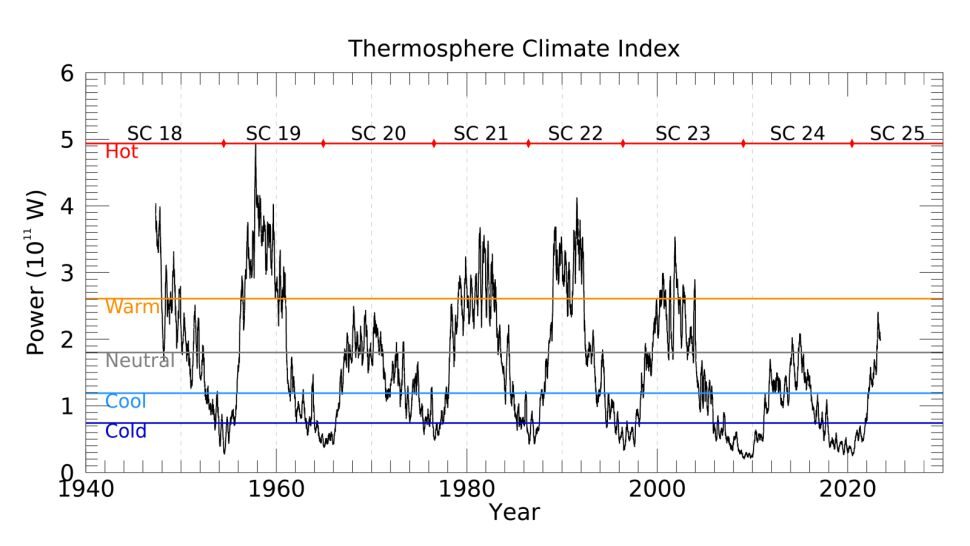
The atmospheric temperature spike, which was caused by successive geomagnetic storms, suggests the "solar maximum" is fast approaching.
Comment: That's unless the sun's activity collapses into sporadic, albeit unprecedented outbursts, which is what mathematician and astrophysicist Valentina Zharkova predicts is occurring amidst what she's calling the Grand Solar Minimum.
The thermosphere extends from the top of the mesosphere, at around 53 miles (85 kilometers) above ground, to the bottom of the exosphere, which begins at around 372 miles (600 km) above the ground, according to NASA. Beyond the exosphere is outer space.
For more than 21 years, NASA has measured the thermosphere temperature via infrared radiation emitted by carbon dioxide and nitric oxide molecules. Scientists convert data collected by NASA's Thermosphere, Ionosphere, Mesosphere, Energetics and Dynamics (TIMED) satellite, into the Thermosphere Climate Index (TCI), which is measured in terawatts, or TW. (1 TW is equal to 1 trillion watts.)
The TCI value, which spiked on March 10, peaked at 0.24 TW, Martin Mlynczak, a leading researcher on the TIMED mission at NASA's Langley Research Center in Virginia and creator of the TCI, told Live Science. The last time the TCI was this high was Dec. 28, 2003. (The temperature spike data has been submitted to a journal but has not yet been peer-reviewed.)
The temperature spike was caused by three geomagnetic storms in January and February — major disturbances to Earth's magnetic field that are triggered by chunks of fast-moving magnetized plasma, known as coronal mass ejections (CMEs), and less often by streams of highly charged particles, known as solar wind, which are both spat out by the sun.
"These 'storms' deposit their energy in the thermosphere and cause it to heat up," Mlynczak said. "The increased heating results in increased levels of infrared emission from nitric oxide and carbon dioxide in the thermosphere." Normally, infrared emissions after a storm cool the thermosphere, he added, but when the storms come back to back the temperature stays high.
Since the spike, at least two more geomagnetic storms have hit our planet — one on March 24, which was the most powerful solar storm to hit Earth for more than six years, and another equally powerful storm on April 24. The TCI values following these storms have remained high but have not yet passed the March peak, Mlynczak said.
Comment: Notably, some of these solar storms haven't been the strongest that Earth has experienced, but their impact on the planet was much more significant: Powerful Solar storm has unusually strong impact on Earth, delays SpaceX rocket launch, stalls oil rigs in Canada

Comment: New research suggests that there are actually two solar cycles occurring at the same time, lasting 17 years each.
As a result, Earth's thermosphere also follows a roughly 11-year cycle, Mlynczak said. Government scientists from NASA and NOAA predicted the next solar maximum will arrive in 2025, which means the warming trend will likely continue over the next few years.
Comment: Evidence is showing that the overall trend is actually for cooling: Sea ice unusually close to coast of northern Iceland
Changes to the thermosphere can pose challenges for satellites in low-Earth orbit that are positioned around the thermosphere's upper boundary, Mlynczak said.
"The thermosphere expands as it warms," Mlynczak said, resulting in "increased aerodynamic drag on all satellites and on space debris." This increased drag can pull satellites closer to Earth, he said, which could cause satellites to crash into one another or completely fall out of orbit, as SpaceX Starlink satellites did in February 2022 after a surprise geomagnetic storm.
Satellite operators can avoid these issues by positioning their spacecraft in a higher orbit when needed, but the unpredictability of space weather makes it hard to know when these manoeuvres are required until it is often too late.
Solar maximum could also arrive sooner than predicted. A recent study published Jan. 30 in the journal Frontiers in Astronomy and Space Sciences suggests that the solar activity peak could arrive as early as late 2023 and be more powerful than initially predicted. If this scenario plays out, then the risk of a satellite disaster further increases.
However, over longer timescales, temperatures in the thermosphere are declining, because excess CO2 in the thermosphere due to climate change increases infrared emissions into space, a May 8 study in the journal Earth Atmospheric and Planetary Sciences found.



Science is now found clueless and models are their way of trying to interpret the current Earth, Sun relationship.
There is in their/ Science eyes an expectation that their logic will give a resolve to this unfolding chaos but I believe that amounts to no more than wishful thinking.
What is happening is so and for a reason, my observations would suggest that our Sun is becoming increasingly volatile and solar surface activities would support such a notion.
NASA are now on the back foot, not a good place for those who think they know it all.